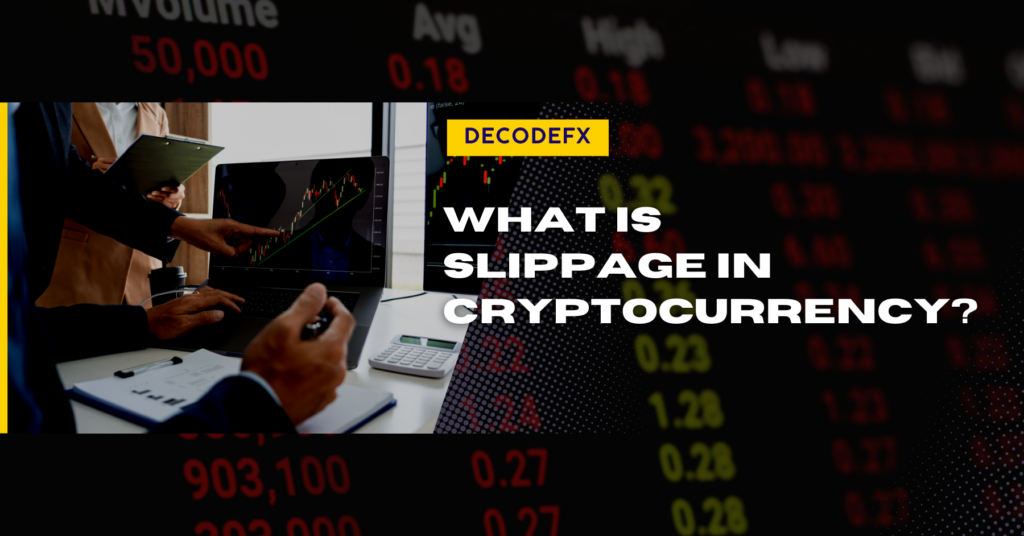Crypto trading can be a lucrative endeavor. But as with any investment, there are certain risks involved. One of these risks is slippage. In this article, we’ll take a look at what crypto slippage is, how it works, and how you can avoid it.
What is Slippage in Crypto?
Cryptocurrencies can be traded on brokerage platforms such as Decode Global. Slippage in crypto refers to the difference between the expected price of a trade and the actual price at which the trade is executed. This can happen for several reasons, but usually, it’s due to market conditions changing rapidly.
There are a few reasons why slippage might occur.
The first is if there’s a difference between the bid price and the ask price. The bid price is the highest price that someone is willing to pay for an asset, while the ask price is the lowest price that someone is willing to sell it for.
If the bid and ask prices are far apart, executing a trade at the expected price can be difficult.
Another reason slippage might occur is if there’s a lot of buying or selling pressure in the market. This causes prices to move rapidly, making it hard to get your trade executed at the expected price.
Finally, slippage can happen simply because the market is volatile and prices are changing rapidly.
How Slippage Works
When you place an order to buy or sell cryptocurrency, you generally expect that order to be filled at the specified price. However, due to the volatile nature of the cryptocurrency market, it’s not uncommon for orders to be filled at a different price than the one you initially specified.
This difference is known as slippage. It can either be positive or negative, depending on whether the trade was executed at a higher or lower price than you expected.
Types of Slippage
So far, we’ve only talked about slippage in general terms. But there are actually two different types of slippage that can occur: positive and negative.
Positive Slippage
Positive slippage occurs when your trade is executed at a higher price than you expected. This is generally seen as a good thing since it means you’re getting more for your money than you initially thought. For example, let’s say you want to buy 1 BTC at $10,000. But when your order is filled, the price has risen to $10,500. In this case, you’ve experienced positive slippage of $500.
Negative Slippage
Negative slippage is the opposite of positive slippage. It occurs when your trade is executed at a lower price than you expected. This can be frustrating since it means you’re not getting as much for your money as you initially thought. For example, let’s say you want to sell 1 BTC at $10,000. But when your order is filled, the price drops to $9,500. In this case, you’ve experienced negative slippage.
But, in practical terms slippage is usually not as large as $500. In fact, it’s often a few pips or points between the bid and ask prices.
Example of Slippage in Crypto
Now that we’ve covered the basics of slippage, let’s take a look at an example.
Imagine you want to buy 1 BTC at $9,000. You place an order to buy at this price, but it isn’t immediately filled due to market conditions. The price of BTC then starts to rise, and by the time your order is finally filled, the price has reached $9,002. In this case, you would have experienced positive slippage of $2.
On the other hand, let’s say you want to sell 1 BTC at $9,000. You place an order to sell at this price, but it isn’t immediately filled. The price of BTC then starts to fall, and by the time your order is finally filled, the price has reached $8,998. In this case, you would have experienced negative slippage of $2.
How To Avoid Slippage
Now that you know what slippage is and how it works, you’re probably wondering how you can avoid it. After all, no one wants to lose money because their trade wasn’t filled at the expected price.
Here are a few tips to help you avoid slippage:
1. Use a limit order instead of a market order
Your trade is filled immediately at the best available price when you place a market order. However, this also means that you’re more likely to experience slippage.
On the other hand, when you place a limit order, your trade will only be filled at the price you specify. This means there’s less chance of your order being filled at a different price, and thus less chance of experiencing slippage.
2. Avoid trading in volatile market conditions
If the market is particularly volatile, it’s more likely that your trade will be filled at a different price than you expected. To avoid this, only trade when the market is relatively stable.
3. Use a reputable exchange
When you’re choosing an exchange to trade on, make sure you choose one that’s reputable and has low fees. This will help to ensure that your trades are executed quickly and at the prices you expect.
4. Trade with caution
When placing a trade, always consider the risks involved. If the market is moving rapidly in one direction or another, there’s a greater chance that your trade will be filled at a different price than you expected.
5. Use stop-loss orders
A stop-loss order is an order to sell a security when it reaches a certain price. This can help to limit your losses if the market moves against you.
Frequently Asked Questions About Slippage
What is the difference between bid-ask spread and slippage?
The bid-ask spread is the difference between the prices buyers are willing to pay and the prices sellers are willing to accept. Slippage occurs when your trade is filled at a different price than you expected.
Is slippage always bad?
No, not necessarily. While negative slippage can be frustrating, positive slippage can be beneficial since it means you’re getting more for your money than you initially thought.
Create a Decode Account Today and Get FREE $DECODE! Scan the QR Code Now!
Decode Coin is the cryptocurrency made by the Decode Group, a financial services company that offers educational training, foreign exchange services, and fund management, with two decades of experience.
The Decode Coin ($DECODE) aims to be the most trusted currency used in the Financial Service industry, being used to settle all fees such as transaction fees and referrer fees. $DECODE may soon be used as a payment for all transactions within the Decode Group and over 50 partner establishments worldwide.
Visit decodeex.com/promo, Register and Verify your Email, Sign-in and Input your ERC-Wallet, Submit KYC requirements, and that’s it! You will be AIRDROPPED your FREE 500 $DECODE within 24 hours.

